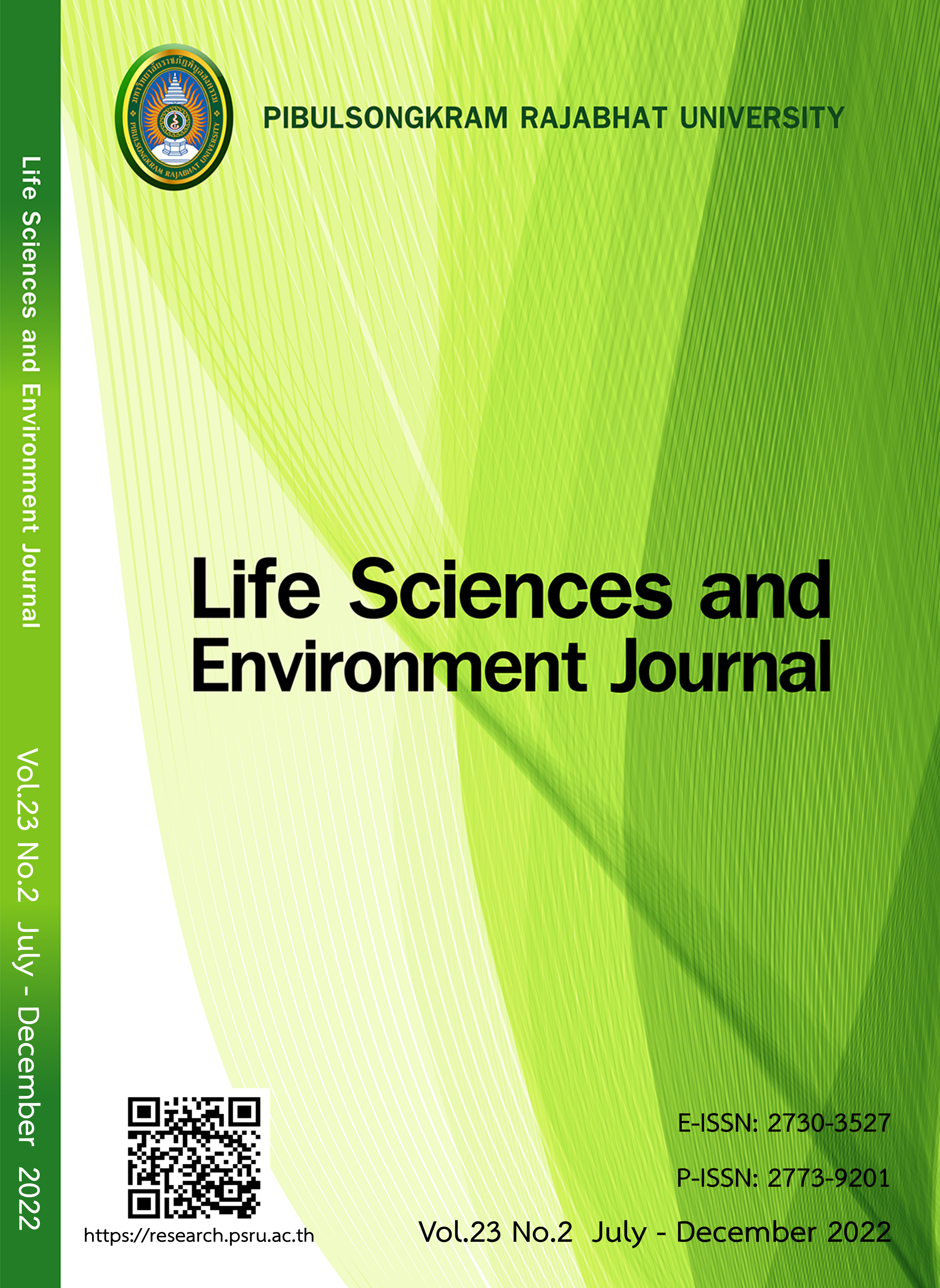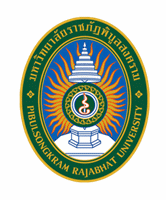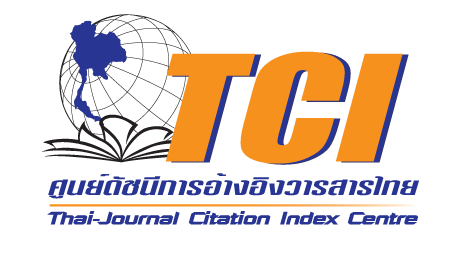องค์ประกอบทางเคมี ฤทธิ์ต้านอนุมูลอิสระ และฤทธิ์ต้านไกลเคชั่น ในน้ำชาผลไม้ตระกูลเบอร์รี่
DOI:
https://doi.org/10.14456/lsej.2022.36คำสำคัญ:
ชาผลไม้ , เบอร์รี่ , สารประกอบฟีนอลิก , ฤทธิ์การต้านอนุมูลอิสระ , ฤทธิ์การต้านไกลเคชั่นบทคัดย่อ
งานวิจัยนี้มีวัตถุประสงค์เพื่อเตรียมชาผลไม้ตระกูลเบอร์รี่ 4 ชนิด ได้แก่ แบล็กเบอร์รี่
แครนเบอร์รี่ ราสป์เบอร์รี่ และมัลเบอร์รี่ หาองค์ประกอบทางเคมี ฤทธิ์ต้านอนุมูลอิสระ และฤทธิ์ต้านไกลเคชั่น
ในน้ำชาเบอร์รี่ โดยนำตัวอย่างผลไม้สดมาทำแห้งแบบเยือกแข็ง ทำให้เป็นผง แล้วแช่ด้วยน้ำร้อน 90-100 องศาเซลเซียส เป็นเวลา 3 นาที หาปริมาณฟีนอลิกทั้งหมดโดยทำปฏิกิริยากับโฟลิน-ซีโอแคลทูรีเอเจนต์ ศึกษาฤทธิ์ตานออกซิเดชัน ด้วยวิธีการทําลายอนุมูลอิสระดีพีพีเอช และความสามารถในการรีดิวซเฟอรริก ศึกษาฤทธิ์ต้านไกลเคชั่นด้วยเครื่องสเปกโตรฟลูออโรโฟโตมิเตอร์ และวิเคราะห์ปริมาณสารประกอบ
ฟีนอลิกสำคัญด้วยเทคนิคโครมาโทกราฟีของเหลวสมรรถนะสูง ผลการทดลองพบว่า ชาผลไม้จาก
มัลเบอร์รี่ มีปริมาณฟีนอลิกรวม (24.45 มิลลิกรัมสมมูลของกรดแกลลิกต่อกรัมตัวอย่างแห้ง) ฤทธิ์การทำลายอนุมูลอิสระดีพีพีเอช (ร้อยละ 94.49) และฤทธิ์ต้านไกลเคชั่นมากที่สุด (ร้อยละ75.83) และพบปริมาณกรดฟีนอลิกสำคัญ ได้แก่ กรดแกลลิก กรดคลอโรจีนิก และกรดคูมาริก (0.38, 0.64, 2.42 มิลลิกรัมต่อกรัม ตามลำดับ) ชาผลไม้จากงานวิจัยนี้เป็นทางเลือกหนึ่งในการใช้ประโยชน์จากเบอร์รี่
มีประโยชน์ต่อสุขภาพ เพราะอุดมด้วยสารประกอบฟีนอลิก มีฤทธิ์การต้านอนุมูลอิสระและฤทธิ์ต้าน ไกลเคชั่นซึ่งเกี่ยวข้องกับการชรา
References
Adisakwattana S. Cinnamic acid and its derivatives: Mechanisms for prevention and management of diabetes and its complication Nutrients 2017;9(2):1-27.
Benzie IFF, Strain JJ. The ferric reducing ability of plasma (FRAP) as a measure of “antioxidant power”: the FRAP assay. Analytical Biochemistry 1996;239:70-76.
Bilawal A, Ishfaq M, Gantumur M-A, Qayum A, Shi R, Fazilani SA, Anwar A, et al. A review of the bioactive ingredients of berries and their applications in curing diseases. Food Bioscience. Published online December, 2021.
Butsat S, Siriamornpum S. Phenolic acid and antioxidant activities in husk of different thai rice varieties. Food Science and Technology International 2010;16(4):329-336.
Brand-williams W, Cuvelier ME, Berset C. Use of a free radical method to evaluate antioxidant activity. Food Science and Technology 1995;28:25-30.
Deetae P, Parichanon P, Trakunleewatthana P, Chanseetis C, Lertsiri S. Antioxidant and anti-glycation properties of Thai herbal teas in comparison with conventional teas. Food Chemistry 2012;133: 953-959.
Prior RL, Wu X. Diet antioxidant capacity: relationships to oxidative stress and health. American Journal of Biomedical Science 2013;5(2):126-139.
Gong Y, Liu X, He WH, Xu HG, Yuan F, Gao YX. Investigation into the antioxidant activity and chemical composition of alcoholic extracts from defatted marigold (Tagetes erecta L.) residue. Fitoterapia 2012;83:481-489.
Hunyadi A, Martins A, Hsieh T, Seres A, Zupko I. Chlorogenic acid and rutin play a major role in the in vivo anti-diabetic activity of Morus alba leaf extract on type II diabetic rats, PLoS ONE 2012;7:1-6.
Katarina S, Gordana Z, Teodora J, Dejan G, Tatjana S, Dejan P. Berry fruit teas: Phenolic composition and cytotoxic activity. Food Research International 2014;62:677–683.
Kaewkaen P, Tong-un T, Wattanathorn J, Muchimapura S, Kaewrueng W, Wongcharoenwanakit S. Mulberry fruit extract protects against memory impairment and hippocampal damage in animal model of vascular dementia. Evidence-based complementary and alternative medicine 2012;(5):263520:1-9.
Methaakkharadecha N, Srisopa A. Phenolic contents and antioxidant activities of Mulberry leaf tea and water soluble Mulberry leaf tea powder. Thai Journal of Science and Technology 2020;9(2):30-242.
Radojkovi MM, Zekovi ZP, Vidovi SS, Kocar DD, Maskovi PZ. Free radical scavenging activity and total phenolic and flavonoid contents of mulberry (Morus spp. L., Moraceae) extracts. Hemijska Industruja 2012; 66(4):547–552.
Rohela GK, Shukla P, Muttanna, Kumar R, Chowdhury SR. Mulberry (Morus spp.): An ideal plant for sustainable development. Trees Forests and People 2020;2:10-12.
Silva JK, Batista AG, Cazarin CBB, Dionisio AP, Brito ES, Marques ATB, Marostica MR. Functional tea from a Brazilian berry: Overview of the bioactives compounds. Food Science and Technology 2017;16(76): 292-298.
Souza VR, Pereira PAP, Silva TLT, Lima LC, Pio R, Queiroz F. Determination of the bioactive compounds, antioxidant activity and chemical composition of Brazilian blackberry, red raspberry, strawberry, blueberry and sweet cherry fruits. Food Chemistry 2014;156:362-368.
Srisopa A, Wongkrajang K. Development of antioxidant and anti-α-glucosidase mulberry leaf tea recipes with combination of aroma herbs, Thai Journal of Science and Technology 2020;9(2):218-229.
Wen P, Hu TG, Linhardt RJ, Liao ST, Wu H, Zou, YX. Mulberry: A review of bioactive compounds and advanced processing technology, Trends in Food Science & Technology 2019;83:138-158.
Vichasilp C, Srithupthai K, Wangtueai S. Development of fruit tea from Mao (Antidesma sp.) seeds; by-products from Mao juice and wine processing. Khon Kaen Agriculture Journal 2017;45(2):393-400.
Zhao W, Cai P, Zhang N, Wu T, Sun A, Jia G. Inhibitory effects of polyphenols from black chokeberry on advanced glycation end-products (AGEs) formation. Food Chemistry. Published online October 30, 2022.
Downloads
เผยแพร่แล้ว
How to Cite
ฉบับ
บท
License
Copyright (c) 2022 Life Sciences and Environment Journal

This work is licensed under a Creative Commons Attribution-NonCommercial-NoDerivatives 4.0 International License.
Each article is copyrighted © by its author(s) and is published under license from the author(s).









